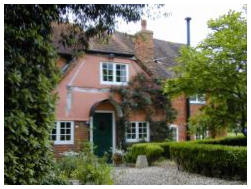


The twentieth century was a period of ever-accelerating change. It saw Aston Abbotts
transformed from a semi-isolated, rural agricultural village to the cosmopolitan
modern village that it is today. Prior to 1900 the changes had been largely cosmetic.
The village had been rebuilt, but village farming life continued as usual.
As the twentieth century advanced labour-intensive farming gave way to mechanised
methods, villagers used improved transport methods to work ever further from home
- and commuters arrived as the new villager of Aston Abbotts.


Twentieth and Twenty-First Century Timeline
1901
The census shows 290 residents
1919
Landowner Lady Wantage sells off several farms
1919
The village applies for a telephone license
1919
The village cricket club is formed
1931
Mains electricity come to the village, but not all households are connected
1933
Electric lighting installed in St James Church
1937
Mains electricity is connected to the school
1939
Piped water supplies arrive in the village
1945
A recreation ground is built
1959
Street lighting is installed in the main part of the village
1959
The village gets a main sewage system
1960
Mains electricity reaches Oxley's Farm
1964
The village cricket club is dissolved
1969
First Parish Council elections are held
1969
Village loses its resident vicar as local parishes become a group benefice
1971
Cublington (Wing) airport proposal defeated
1972
Major Morton, landowner and owner of The Abbey, dies
1975
The vicarage is sold to a private owner
1978
The village school closes
1983
A survey shows 280 villagers and 120 houses
1983
The village magazine 'The Chronicle' is launched
1984
Aston Abbotts wins best kept village in Bucks competition
1989
A plan to build affordable housing on the village outskirts is turned down
1989
Parts of Aston Abbotts are designated a Conservation Area (see Map)
1990
The village Post Office closes
1991
The census shows 396 residents
1993
The Primitive Methodist Chapel closes
1994
Mains gas arrives in the village
1996
Nash's Farm is demolished to make way for twelve houses
1998
Mrs Tunnicliffe becomes the parish's first woman priest
2001
Home Farm is sold. Some of its land is sold for housing development
2003
The Bull and Butcher public house closes and the site is redeveloped as 10
dwellings
2005
Osborn’s shop closes
2011
Vic Scott, well-known local naturalist and life-long resident of Aston Abbotts passes
away
2011
The 2011 census records 366 inhabitants in 167 households
2013
The village is granted a lease for the Church Room, now renamed the Village Hall
2014
Bernard Osborn of Osborn’s shop passes away (see Bernard Osborn interview)
2016
The Village Hall Trustees obtain major funding for renovation of the hall
2017
The Village Hall is re-opened after major renovation
2018
The Abbey is sold and renovation begins
2019
Aston Abbotts wins Bucks Best Kept Village (less than 500 inhabitants category)
2021
The Royal Oak owners announce that they will not re-open the pub post-pandemic
2022
Aston Abbotts wins Bucks Best Kept Village again
Dramatic Changes
The needs of a village population are far different from villagers’ needs in the mid twentieth
century and huge changes have taken place.
In the last 50 years or so we have lost: the cricket team, the ladies club, two pubs, the darts
team, the football team, the youth club, the village shop, the Post Office, the telephone
exchange, the bakery, the Old Master’s restaurant, the village school, and the Methodist
chapel.
Despite these changes, Aston Abbotts remain an active and vibrant village community.


- Photos
- Aston Abbotts - Winter Pictures
- Aston Abbotts How It Was
- Villagers Pictures - General
- Villagers Pictures - Ken Rhodie
- 630 Club Bean Competition 2011
- Astonbury X 2011 - Page 1
- Astonbury X 2011 - Page 2
- Astonbury X 2011 - Page 3
- Vic Scott Memorial Orchard
- Christmas Lunch 2011
- Peter Kent's Photographs
- Jubilee Picnic 2012
- Village Orchard - One Year On
- Village Orchard - Autum 2012 Planting
- Astonbury 2012
- Videos
- Interviews















